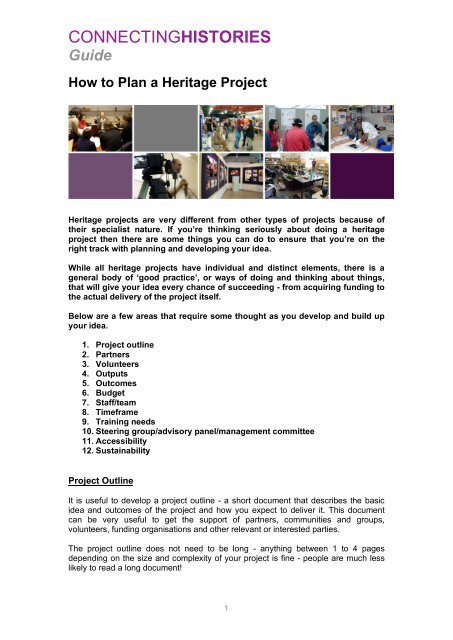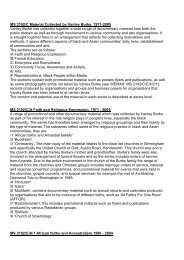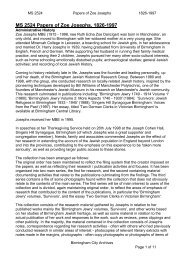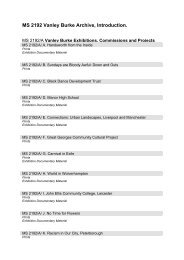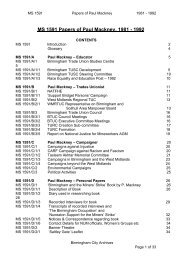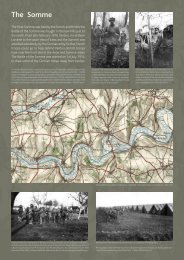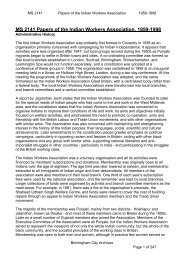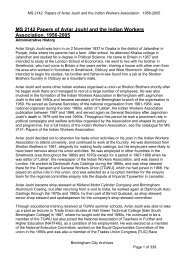How to Plan a Project - Connecting Histories
How to Plan a Project - Connecting Histories
How to Plan a Project - Connecting Histories
Create successful ePaper yourself
Turn your PDF publications into a flip-book with our unique Google optimized e-Paper software.
CONNECTINGHISTORIESGuide<strong>How</strong> <strong>to</strong> <strong>Plan</strong> a Heritage <strong>Project</strong>Heritage projects are very different from other types of projects because oftheir specialist nature. If you’re thinking seriously about doing a heritageproject then there are some things you can do <strong>to</strong> ensure that you’re on theright track with planning and developing your idea.While all heritage projects have individual and distinct elements, there is ageneral body of ‘good practice’, or ways of doing and thinking about things,that will give your idea every chance of succeeding - from acquiring funding <strong>to</strong>the actual delivery of the project itself.Below are a few areas that require some thought as you develop and build upyour idea.1. <strong>Project</strong> outline2. Partners3. Volunteers4. Outputs5. Outcomes6. Budget7. Staff/team8. Timeframe9. Training needs10. Steering group/advisory panel/management committee11. Accessibility12. Sustainability<strong>Project</strong> OutlineIt is useful <strong>to</strong> develop a project outline - a short document that describes the basicidea and outcomes of the project and how you expect <strong>to</strong> deliver it. This documentcan be very useful <strong>to</strong> get the support of partners, communities and groups,volunteers, funding organisations and other relevant or interested parties.The project outline does not need <strong>to</strong> be long - anything between 1 <strong>to</strong> 4 pagesdepending on the size and complexity of your project is fine - people are much lesslikely <strong>to</strong> read a long document!1
Producing it will enable you <strong>to</strong> talk about your project clearly and with confidence.This will help secure support for your project; it will demonstrate <strong>to</strong> funders andpotential partners that you have thought seriously about your project idea and that itis worthwhile for them <strong>to</strong> get involved and offer their time and support.The project outline will probably address many of the following issues and activities.PartnersPartners are vital <strong>to</strong> the success of a project and come in a variety of forms, shapesand sizes. They can potentially include community groups and the voluntary sec<strong>to</strong>r,funding organisations, local authorities, heritage sec<strong>to</strong>r organisations (such asarchives, libraries and museums), schools and academic institutions, professionalnetworks, and many others. Partners will enable you <strong>to</strong> not only develop your project,but will help you develop the confidence <strong>to</strong> deliver a project.Partnerships are established so that your project can utilise knowledge, skills andresources that you may not have, but that you can draw on from elsewhere.Partnerships increase the likelihood of your project being completed successfully andon time. When thinking about establishing partnerships it is important <strong>to</strong> think aboutwho you need <strong>to</strong> approach and why - be strategic.When thinking of possible partners consider the following questions:• which aspects of the project do you need support?• what are the key skills and insights you lack?• what additional resources might you need?• what is the best way of doing things and who can tell you about anystandards that you need <strong>to</strong> meet?• Who else might be interested in doing the same sort of work?Also try not <strong>to</strong> forget your partner’s needs and aspirations - what do they need <strong>to</strong>achieve from being part of your project?VolunteersVolunteers are an excellent way of getting additional support for a project. Providedthey have adequate training and management support, volunteers can undertake avariety of tasks and help in the successful delivery of the project. Having volunteersalso provides the opportunity for outcomes such as the transfer of skills, experienceand confidence and can help with sustaining aspects of the project. Again, rememberthat volunteers need <strong>to</strong> benefit – either through developing useful new skills orgetting useful experience that will help them access training or jobs.Some funding organisations insist on the engagement of volunteers as this is seenas an important way of involving communities, particularly, if the funding is publicmoney (e.g. HLF) and therefore there is a need <strong>to</strong> ensure that the wider publicbenefits from the project’s activities.2
OutputsWhat are your outputs? What do we mean by outputs?All projects have what are called outputs. Outputs are the things that your project hasset out <strong>to</strong> produce. For heritage projects, outputs can include exhibitions, collectionsof archives, publications, oral his<strong>to</strong>ry recordings, video or film, a website, events,volunteer programmes etc.Outputs are important as they are the products of your project and are what youleave behind as its legacy. So when thinking about and planning your project youneed <strong>to</strong> give a lot of thought <strong>to</strong> what the project will produce.Importantly, outputs have <strong>to</strong> be conceived within the context of the budget andtimeframe of the project. This ensures an understanding of what is realisticallyachievable and improves likelihood of securing funding and, ultimately, leads <strong>to</strong> thesuccessful delivery of the project.OutcomesOutcomes are different <strong>to</strong> outputs. Whereas the term ‘output’ refers <strong>to</strong> the actualthings your project may produce or deliver, outcomes are benefits your project mightbring about. Having an understanding of this will enable you <strong>to</strong> put <strong>to</strong>gether a strongproject idea and application.Outcomes might include an increase in or the transfer of skills and experience, anincrease in knowledge and confidence, an increase in the numbers of people using aservice or increased interest in heritage. Outcomes may be measured qualitatively(e.g. impact on attitudes and feelings) or quantitatively (e.g. how many people usinga service).Budget<strong>How</strong> much is your project going <strong>to</strong> cost? This very much depends on what you plan<strong>to</strong> do in your project. The available budget for the project also depends on whichfunding organisation you are applying <strong>to</strong> and their funding remit and criteria.A project generally will require someone <strong>to</strong> manage and deliver project activities,either paid staff or voluntary time. Larger projects may also have other staff -administrative or a technical or specialist member of the team needed <strong>to</strong> help withthe delivery of the project such as oral his<strong>to</strong>ry or a website. A significant proportion ofthe project’s funding may be used for salaries, so it is useful <strong>to</strong> carefully considerwhat capacity and skills you need and the cost implications of staffing for the project(see below for more details).<strong>Project</strong> outputs will also take up a significant proportion of the funding. It is crucial <strong>to</strong>get a working idea of what these will cost. Getting quotes from designers, publishers,writers, freelance staff or consultants is always important and will demonstrate <strong>to</strong>funding organisations that you have properly thought your idea through.If your project intends <strong>to</strong> employ people on contracts <strong>to</strong> deliver aspects of the project,for example <strong>to</strong> design an exhibition or write a publication etc. it is a good idea <strong>to</strong> get3
more than one quote - this is particularly important if the contract is likely <strong>to</strong> be for asignificant amount. Some funding organisations may have a threshold below which itis not necessary <strong>to</strong> get more than one quote, but above which it is essential (e.g. theHeritage Lottery Fund requires at least three quotes for contracts or jobs that will costmore than £5,000 and that are not intended <strong>to</strong> be delivered by the project’s corestaff).You also need <strong>to</strong> think about the resources your project will require such as officeoverheads, equipment, ICT and other media.Staff/TeamYour project will need a team <strong>to</strong> help deliver it. Funding organisations will require you<strong>to</strong> demonstrate that you have considered this in full. Indeed, some fundingorganisations will insist that your project establishes a post specifically tasked <strong>to</strong>manage/coordinate your activities.Your project team (even if the team consists of a single individual directly employedby the project) will be employed <strong>to</strong> enable the delivery of tasks set out in theaccepted project proposal. For example, a large ‘Your Heritage’ HLF project (grantsof up <strong>to</strong> £50,000) will probably require a project manager/coordina<strong>to</strong>r. This individualmay be employed full-time or part-time and this will also have an impact on the lengthof the project and its budget as a full-time post will cost more than a part-time pos<strong>to</strong>ver a specified period.Think about any additional posts that your project may require (e.g. admin staff) butremember that you also need <strong>to</strong> leave a sufficient budget for the outputs youpropose. It is important <strong>to</strong> discuss these issues with the funding organisation so thatyou are on the right track.TimeframeAll projects have a specified time-scale. In other words, how long is your projectgoing last? This has implications on cost and resources. Within that overall timeframethere may be a number of stages and deadlines - what might these be? Whendeveloping your project you will need <strong>to</strong> think about these.Careful planning of these issues demonstrates <strong>to</strong> funding organisations and otherpartners that you have thought your project through. As projects do unravelorganically and can change you will probably need <strong>to</strong> think about a contingency, inthe event the project is unable meet some of those targets and deadlines – in otherwords, a back-up plan.Training needsThe specialist nature of heritage projects might mean that there is a specific skillsshortage. Specialist areas may include archives-related activities such as cataloguingand listing, conservation and packing/repacking; interviewing skills for oral his<strong>to</strong>ry;publications; interpreting and designing exhibitions; websites; delivery of training;workshops and programmes.4
It is important <strong>to</strong> develop your project with this in mind. What are the key areas inwhich your project may require support? What are project’s training needs? Who maybe able <strong>to</strong> offer the relevant support?Your initial project outline can explore this - your final application should demonstratethat you have addressed this.Steering Group/Advisory Panel/Management CommitteeYour project will need <strong>to</strong> establish a working group designed <strong>to</strong> steer or advise theproject. Such a group may be called a management committee, steering group,advisory panel etc. Importantly, this group should function <strong>to</strong> assist the project(though the specific remit and scope of its activities, influence and authority will need<strong>to</strong> specified in advance).This group should bring <strong>to</strong>gether people who will provide the skills, experience,knowledge, and networking necessary <strong>to</strong> make the project a success. This group willmeet at set intervals as appropriate for your project e.g. once every two months.AccessibilityYour project will need <strong>to</strong> consider access issues - how will the public get <strong>to</strong> hearabout your project and its outputs? <strong>How</strong> will you make your project outputsaccessible <strong>to</strong> the wider public? Where will you put, s<strong>to</strong>re or display them? Whatmethods will you use <strong>to</strong> ensure that the public or a given community can engage withthe project and, later, with its outputs? There are a range of options – speaking <strong>to</strong>experienced partners is one way using existing expertise.SustainabilityFinally, how will your project ensure that benefits and outcomes will be felt beyondthe life of the project?This is an important area and is about maximising the opportunity the project hascreated. In other words, ensuring the project has got the most out of the moneyreceived, for example, it may be achieved by depositing a project’s archive collectionwith an established archive that can ensure access on the project’s behalf; through awebsite; through a publication given free <strong>to</strong> libraries and schools; or through thetransfer of skills and experience. Remember, if your project is important enough foryou <strong>to</strong> spend the amount of time and energy required <strong>to</strong> plan and deliver itsuccessfully, then it’s important enough <strong>to</strong> ensure that the benefits last as long aspossible.Compiled by Izzy Mohammed, June 2007www.connectinghis<strong>to</strong>ries.org.uk5


